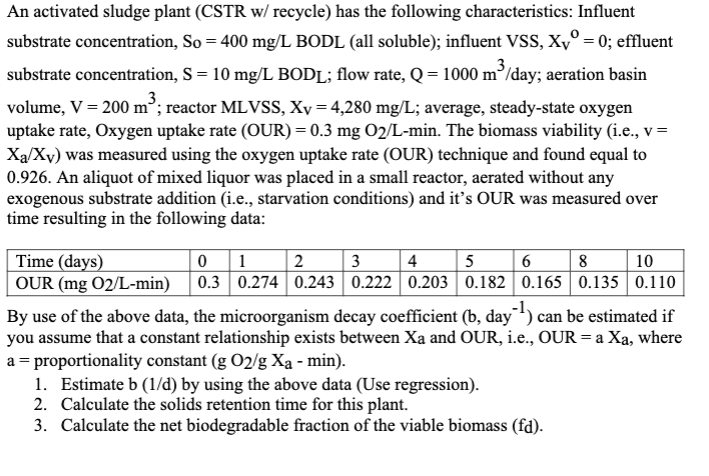An activated sludge plant (CSTR w/ recycle) has the following characteristics: Influent substrate concentration, So = 400 mg/L BODL (all soluble); influent VSS, Xvº = 0; effluent 3 substrate concentration, S = 10 mg/L BODL; flow rate, Q = 1000 m³/day; aeration basin volume, V = 200 m³; reactor MLVSS, Xy = 4,280 mg/L; average, steady-state oxygen uptake rate, Oxygen uptake rate (OUR) = 0.3 mg 02/L-min. The biomass viability (i.e., v = Xa/Xv) was measured using the oxygen uptake rate (OUR) technique and found equal to 0.926. An aliquot of mixed liquor was placed in a small reactor, aerated without any exogenous substrate addition (i.e., starvation conditions) and it's OUR was measured over time resulting in the following data: 0 1 2 3 4 5 6 8 10 Time (days) OUR (mg 02/L-min) 0.3 0.274 0.243 0.222 0.203 0.182 0.165 0.135 0.110 By use of the above data, the microorganism decay coefficient (b, day) can be estimated if you assume that a constant relationship exists between Xa and OUR, i.e., OUR = a Xa, where a = proportionality constant (g O2/g Xa - min). 1. Estimate b (1/d) by using the above data (Use regression). 2. Calculate the solids retention time for this plant. 3. Calculate the net biodegradable fraction of the viable biomass (fd).
An activated sludge plant (CSTR w/ recycle) has the following characteristics: Influent substrate concentration, So = 400 mg/L BODL (all soluble); influent VSS, Xvº = 0; effluent 3 substrate concentration, S = 10 mg/L BODL; flow rate, Q = 1000 m³/day; aeration basin volume, V = 200 m³; reactor MLVSS, Xy = 4,280 mg/L; average, steady-state oxygen uptake rate, Oxygen uptake rate (OUR) = 0.3 mg 02/L-min. The biomass viability (i.e., v = Xa/Xv) was measured using the oxygen uptake rate (OUR) technique and found equal to 0.926. An aliquot of mixed liquor was placed in a small reactor, aerated without any exogenous substrate addition (i.e., starvation conditions) and it's OUR was measured over time resulting in the following data: 0 1 2 3 4 5 6 8 10 Time (days) OUR (mg 02/L-min) 0.3 0.274 0.243 0.222 0.203 0.182 0.165 0.135 0.110 By use of the above data, the microorganism decay coefficient (b, day) can be estimated if you assume that a constant relationship exists between Xa and OUR, i.e., OUR = a Xa, where a = proportionality constant (g O2/g Xa - min). 1. Estimate b (1/d) by using the above data (Use regression). 2. Calculate the solids retention time for this plant. 3. Calculate the net biodegradable fraction of the viable biomass (fd).
Chapter12: Water Requirements For Aquaculture
Section: Chapter Questions
Problem 24SA
Related questions
Question

Transcribed Image Text:An activated sludge plant (CSTR w/ recycle) has the following characteristics: Influent
substrate concentration, So = 400 mg/L BODL (all soluble); influent VSS, Xyº = 0; effluent
3
substrate concentration, S = 10 mg/L BODL; flow rate, Q = 1000 m³/day; aeration basin
3
volume, V = 200 m³; reactor MLVSS, Xv = 4,280 mg/L; average, steady-state oxygen
uptake rate, Oxygen uptake rate (OUR) = 0.3 mg 02/L-min. The biomass viability (i.e., v =
Xa/Xv) was measured using the oxygen uptake rate (OUR) technique and found equal to
0.926. An aliquot of mixed liquor was placed in a small reactor, aerated without any
exogenous substrate addition (i.e., starvation conditions) and it's OUR was measured over
time resulting in the following data:
0 1
2
3
4
5
Time (days)
OUR (mg 02/L-min) 0.3 0.274 0.243| 0.222 0.203 0.182
6
8
10
0.165 0.135 0.110
By use of the above data, the microorganism decay coefficient (b, day can be estimated if
you assume that a constant relationship exists between Xa and OUR, i.e., OUR = a Xa, where
a = proportionality constant (g O2/g Xa - min).
1. Estimate b (1/d) by using the above data (Use regression).
2. Calculate the solids retention time for this plant.
3. Calculate the net biodegradable fraction of the viable biomass (fd).
Expert Solution
This question has been solved!
Explore an expertly crafted, step-by-step solution for a thorough understanding of key concepts.
This is a popular solution!
Trending now
This is a popular solution!
Step by step
Solved in 3 steps

Follow-up Questions
Read through expert solutions to related follow-up questions below.
Follow-up Question
The last part doesn't have an answer. Can someone help?
Solution
Knowledge Booster
Learn more about
Need a deep-dive on the concept behind this application? Look no further. Learn more about this topic, biology and related others by exploring similar questions and additional content below.Recommended textbooks for you


Essentials of Pharmacology for Health Professions
Nursing
ISBN:
9781305441620
Author:
WOODROW
Publisher:
Cengage


Essentials of Pharmacology for Health Professions
Nursing
ISBN:
9781305441620
Author:
WOODROW
Publisher:
Cengage